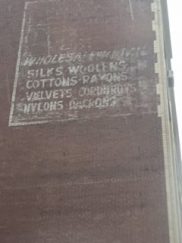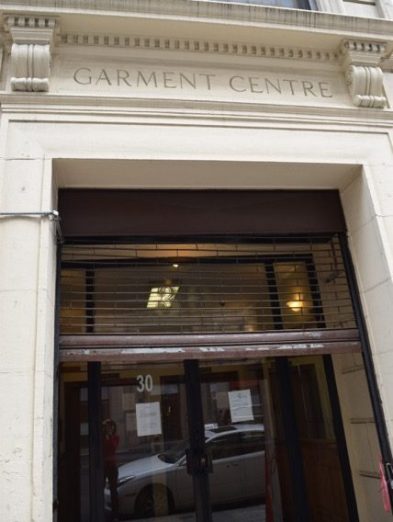We’ve all heard about the sense of loss that manufacturing jobs leave in their wake as they disappear overseas. Some call it foolish nostalgia. The jobs aren’t coming back, they say. Not with automation. Not with global outsourcing. Not with our collective drive for cheaper labor and faster production.
To understand this loss, we need look no further than our own back yards. Boston’s former Garment District was once home to the city’s largest manufacturing industry, employing thousands of immigrant union workers throughout the 20th century, including many from the North End. My grandmother was one of them.
Manufacturing cities with strong unions, like Boston, created more than just jobs. They knitted together classes and cultures. They offered security, community, and optimism. They interwove city and family histories.

In 1920, at the age 13, my grandmother immigrated from Italy with her family, settling into a third-floor apartment on Hanover Street. She left school to work as a stitcher, eventually finding a place in one of the Garment District “shops” and joining the International Ladies’ Garment Workers Union (ILGWU).
My grandmother rarely spoke about her work in the Garment District. When she retired in 1983, there were still about 4,000 unionized garment workers in Boston making women’s apparel. Today there isn’t one. So when I met Warren Pepicelli, I found the thread to Boston’s manufacturing past ― and my own family’s history ― that I was looking for.

Pepicelli joined the ILGWU as a business manager in 1982. He never knew my grandmother, but he organized garment workers like her, many of them immigrants who walked to work from the North End, Chinatown and other nearby Boston neighborhoods. When we met, Pepicelli was dressed in a three-piece suit. He never goes to work in anything else, he told me. In his neatly cropped beard, he looks like the actor Stanley Tucci.
His 8th floor office on Harrison Avenue could be a chic condo ― the walls have been stripped to the brick, the wood floors sanded and polished. This used to be ILGWU space, where strikes were planned and contracts negotiated. Pepicelli is now executive vice president to the New England Joint Board (NEJB) of UNITE HERE (the labor union that absorbed the ILGWU and today represents workers in laundry, food service, textile and other industries).
The first thing Pepicelli showed me when I entered his office is the sewing needles caught between the floorboards. “Stitchers worked here,” he said. “The men pressed and cut the cloth. The women stitched. Your grandmother would have used a single-needle machine,” he said. I imagined rows of stitchers, fingers working fast, driving material through pounding machines. When the needles broke from wear, they were swept between the floorboards.
 His windows look out over Chinatown’s mesh of streets and red brick buildings. Not long ago, this was also Boston’s Garment District with its patchwork of players – manufacturers that owned the material; contracting shops that hired skilled workers to cut, stitch, and press the fabric; and a union that looked out for the wages and welfare of workers.
His windows look out over Chinatown’s mesh of streets and red brick buildings. Not long ago, this was also Boston’s Garment District with its patchwork of players – manufacturers that owned the material; contracting shops that hired skilled workers to cut, stitch, and press the fabric; and a union that looked out for the wages and welfare of workers.
“There was a lot of pressure in this business,” he said. Demand for women’s clothing changed with seasons and styles. Bosses haggled over costs and timelines while workers quibbled over bundles of piecework. “But within all that, there was some feeling of responsibility to each other,” Pepicelli said. “I miss it very much.”
Boston’s Garment District was a place where the American Dream took hold. A presser could become a boss by renting a floor and two dozen sewing machines in one of the old brick buildings on Beach or Harrison or Chauncy Street. “Back then, he’d figure he could get a Cracker Jack Italian woman or Chinese woman who knows how to stitch,” Pepicelli told me. “And she can get 20 of her friends and, like that, he can set up a contracting shop.”
As early as the 1930s, manufacturers started leaving Boston in search of cheaper labor. In the 1950s, plans for the elevated central artery endangered the district. With the 1970s and 80s came high rents and competition from overseas labor. Consumers’ styles changed too. Gone were tailored garments in favor of easily made jeans and t-shirts. Today only 2% of women’s garments are made in the U.S.
“We no longer make things in this city. We’ve lost that diversity in employment,” Pepicelli said. He is not nostalgic, but he understands what’s lost when the availability of manual work close to home that helped so many immigrant workers integrate into American society disappears. A union job that promised fair wages and health benefits helped my grandparents save enough to buy a house in the suburbs in the 1940s. And Boston’s Garment District gave my grandmother a job to return to when she was widowed at the age of 46 with a child to raise.
What remains of Boston’s Garment District are a few signs fading from brick and etched into concrete, and the stitchers’ needles at rest among the floorboards.
Elizabeth Christopher is a writer for a global outsourcing firm in Charlestown, MA, just over the harbor from the North End where her grandmother settled after immigrating from Italy in 1920.






Interesting and moving account of a rich period in Boston history. It also serves as an important reminder of the impact on manufacturing, immigration, and communities from automation and global outsourcing. Excellent read.
I enjoyed reading this article. It’s amazing to think that our grandparents were sustained by this industry and were able to improve their economic situation and make better lives for themselves and eventually their children. It’s sad, too, to see how we’ve lost home-grown manufacturing and an important engine of economic growth in our country. Thank you for this enlightening article. Makes me want to learn more